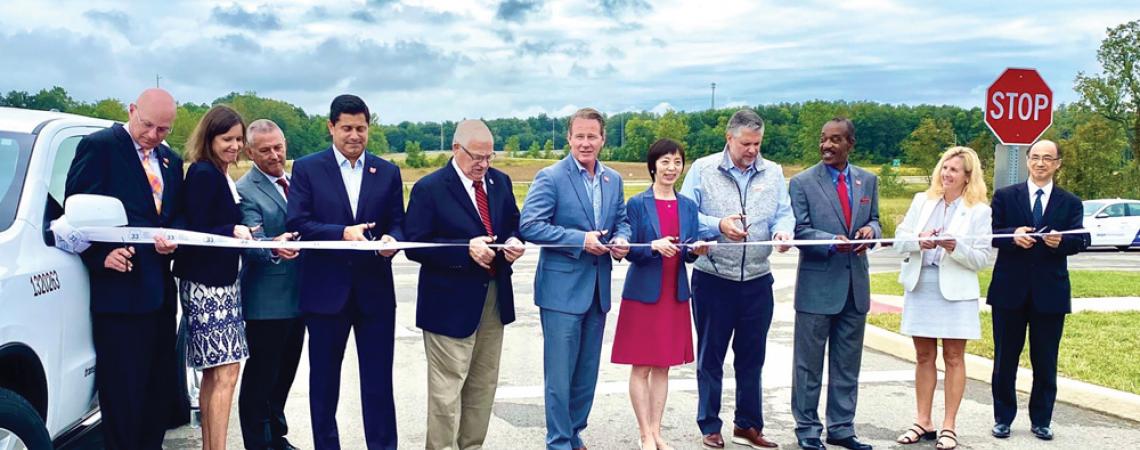Ohio, a state long-obsessed with being in motion, has a rich history of being on the leading edge of transportation innovation.
In the late 19th century, John Lambert, from Mechanicsburg and later Van Wert County, built the first gasoline-powered vehicle in the U.S. (he also was involved in the first motor-vehicle crash in the U.S.). Ohioan Charles Kettering revolutionized the auto industry when he invented the electric starter. An Ohio manufacturer was the first to put seat belts in cars.
It’s not surprising that the Transportation Research Center (TRC) near East Liberty has grown from its beginnings as an Ohio State University research center in the 1960s to become North America’s largest and most advanced vehicle proving ground.
And from that, the next generation of transportation research has sprouted — the 33 Smart Mobility Corridor, billed as the most connected highway in the world.
The 33 Smart Mobility Corridor is the most connected highway in the world and includes a 35-mile section of U.S. Route 33 from Dublin to East Liberty, Ohio.
The 35-mile section of U.S. Route 33 runs from Dublin through Marysville and up to the gates of the TRC in East Liberty. It’s a one-of-a-kind vehicle testing ground that seeks to shape the future of connected and driverless vehicles.
What is smart mobility? Imagine this scenario: You’re driving along the highway when you receive a sudden braking alert. There is an obstacle in the road that cars ahead of you are braking hard to avoid. Those vehicles closest to the obstacle communicate a warning to other approaching vehicles to let them know to slow down to avoid the obstacle and other cars. That’s smart mobility in action.
The system can also notify drivers of potential icy spots on the roads, approaching emergency vehicles, traffic lights getting ready to change, pedestrians, or oncoming bad weather. Smart mobility helps take surprises out of driving and empowers drivers to make better decisions.
“The tech infrastructure being deployed on the 33 Smart Mobility Corridor will help develop and advance transportation technologies that will make travel safer for everyone,” says Ohio Lt. Gov. Jon Husted, who serves as director of InnovateOhio, which aims to make the state a leader in technology innovation.
The Honda Motor Company and its affiliates have played a major role in the guidance and support of the corridor. With an auto manufacturing facility as well as its research and development arm located in Marysville, Honda has deployed over 200 connected vehicles to study the interaction between drivers and smart mobility technology. “Ohio’s 33 Smart Mobility Corridor enables us to conduct real-world testing of Honda’s ‘Safe Swarm’ technology, which uses ‘vehicle-to-everything’ communication to help mitigate collisions, improve traffic flow, increase fuel efficiency for all road users, and prepare for higher levels of automated driving features,” says Sue Bai, chief engineer at Honda Research Institute USA.
The Smart Mobility Corridor has created another Ohio first in transportation research: the world’s first fully connected city. All the intersections within the city of Marysville are connected to the 432 strands of fiber-optic cable that are the central nervous system of the project, so researchers can quickly and easily test the latest safety technology regarding traffic signal phases, traffic timing, and other data.
“What’s nice about Marysville is that we are a self-contained, smaller-sized city with a manageable traffic flow, so we have the ability to shut down an intersection or redirect traffic for testing with minimal effort or impact on the surrounding community,” says Terry Emery, Marysville’s city manager. “We are the perfect testing playground.”
The city of Dublin serves as another live laboratory, connecting some of its intersections with the system to provide vehicle data regarding multilane roundabouts and other traffic situations.
The 33 Smart Mobility Corridor started as a local initiative in 2014 to bring fiber-optic broadband to Marysville and surrounding rural areas, but pivoted into a transportation test bed. That conversion has resulted in unique partnerships across local, state, federal, private, industrial, and academic institutions.
Tim Hansley, Union County administrator and president of the NW 33 Innovation Corridor Council of Governments, says the collaborative nature of those partnerships is what allows the system to work so well. “It’s unusual to have such a cooperative collaboration among all of these different groups,” he says. “We are a model for the rest of the country on how to do this.”
Obviously, having a reliable source of electricity to power the 63 roadside units that collect and distribute data is a crucial component to the system, and Marysville-based Union Rural Electric Cooperative, Inc. (URE), has been an important partner.
“URE played an important part in bringing together the other electric utilities, ODOT, and Union County officials to efficiently power the 33 Smart Mobility Corridor,” says Anthony Smith, URE’s CEO/president. “Providing power to this project was unlike anything we had done before, and the team effort was critical to getting the job done right. We’re proud to have played a role in such an important mobility research program.”











